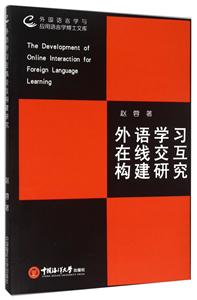-
>
考研英语背单词20个词根词缀
-
>
西班牙语词根宝典
-
>
美国K-12原版语文课本--初中·下(全12册)
-
>
流浪地球刘慈欣
-
>
西南联大英文课 轻读礼盒版
-
>
英语大书虫世界经典名译典藏书系:中国人的精神 (英汉对照)(精选权威版本)
-
>
许渊冲译唐诗三百首:汉文·英语
外语学习在线交互构建研究 版权信息
- ISBN:9787567008885
- 条形码:9787567008885 ; 978-7-5670-0888-5
- 装帧:一般胶版纸
- 册数:暂无
- 重量:暂无
- 所属分类:>
外语学习在线交互构建研究 本书特色
赵蓉编著的《外语学习在线交互构建研究(英文版)》共由七个部分构成。**部分是引言,主要介绍研究背景、研究问题、核心概念和组织框架。**章是文献综述,主要阐述了在线语言学习、在线学习学习成果、学习者继续学习意愿、在线交互所涉及的各个理论,包括等效理论、在线学习社区组织框架理论、互动假设、社会文化理论、支架理论、TAM模型和ECM模型等。第二章是研究模型与假设,该章在TAM与ECM模型的基础上。构建研究模型,探究外语在线学习中交互的建设,通过该交互建设对学习者继续学习意愿的影响,验证该交互建设的有效性。第三章是有关研究方法,具体包括问卷、访谈两种方法,并通过结构方程分析所获得的数据。第四章是讨论,论文依据数据分析,对外语学习在线交互建设、交互建设与继续学习意愿之间的关系,展开深入分析与科学探讨。第五章是有关研究的理论贡献与实践运用。*后一部分是总结,主要指出研究的不足之处与今后的研究方向。
外语学习在线交互构建研究 内容简介
《外国语言学与应用语言学博士文库:外语学习在线交互构建研究(英文版)》共由七个部分构成。**部分是引言,主要介绍研究背景、研究问题、核心概念和组织框架。**章是文献综述,主要阐述了在线语言学习、在线学习学习成果、学习者继续学习意愿、在线交互所涉及的各个理论,包括等效理论、在线学习社区组织框架理论、互动假设、社会文化理论、支架理论、TAM模型和ECM模型等。第二章是研究模型与假设,该章在TAM与ECM模型的基础上。构建研究模型,探究外语在线学习中交互的建设,通过该交互建设对学习者继续学习意愿的影响,验证该交互建设的有效性。第三章是有关研究方法,具体包括问卷、访谈两种方法,并通过结构方程分析所获得的数据。第四章是讨论,论文依据数据分析,对外语学习在线交互建设、交互建设与继续学习意愿之间的关系,展开深入分析与科学探讨。第五章是有关研究的理论贡献与实践运用。*后一部分是总结,主要指出研究的不足之处与今后的研究方向。
外语学习在线交互构建研究 目录
1 Research Background
2 Statement of the Problem
3 Purpose of the Study
4 Conceptual Framework
5 Organization of the Dissertation
Chapter One Literature Review
Introduction
1.1 Online Language Learning
1.1.1 Online Education
1.1.2 Research Status of Online Language Learning
1.1.3 Foreign Language Learning
1.2 Benefits of Online Education
1.2.1 Organizational Framework of Online Learning Community
1.2.2 Sense of Community
1.3 Learners' Continuance Intention Toward Online Education"
1.3.1 TAM
1.3.2 ECM
1.4 Interaction in Distance Education
1.4.1 Definition
1.4.2 Instructional Interaction
1.4.3 System Interactivity
1.5 Equivalence Theory
1.5.1 Online Interactions with Learners
1.5.2 Equivalence Theory
1.6 Interaction Hypothesis (IH)
1.6.1 VersionsoflH
1.6.2 Deficiencies of IH
1.7 Socio-cultural Theory
1.7.1 ZPD
1.7.2 Mediation
1.7.3 Language, as a Symbolic Tool for Mediation
1.8 Scaffolding
1.8.1 Metaphor and Definition
1.8.2 Features and Functions of Scaffolding
1.8.3 Design of Scaffolding in Online Education
Summary
Chapter Two Research Model and Hypotheses
Introduction
2.1 Interaction in Online Language Learning
2.1.1 Interactivity and Scaffolding
2.1.2 Scaffolding Sources Versus Preconditions
2.1.3 Scaffolding Features and Dimensions
2.1.4 Scaffolding Dimensions and Scaffolding Types
2.2 Online Interaction and Continuance Intention
2.2.1 TAM
2.2.2 ECM
2.2.3 Sense of Community
2.2.4 Interaction Construction
2.2.5 Second-Order Construct of Scaffolding
Summary
Chapter Three Methodology
Introduction
3.1 Survey Instrument
3.1.1 0perationalizing the Second-Order Construct of Scaffolding
3.1.2 Developing the Survey Instrument
3.2 Pilot Test
3.3 Participants and Procedure
3.4 Analysis and Results
3.4.1 The Measurement Model
3.4.2 Common Method Bias
3.4.3 Hypothesis Testing
Summary
Chapter Four Discussion
Introduction
4.1 Online Interaction Construction
4.1.1 Integral Constituents of Online Interaction
4.1.2 Construction of Scaffolding
4.2 Correlation Between Interaction and Continuance Intention
Summary
Chapter Five Contributions and Implications
Introduction
5.1 Theoretical Contributions
5.2 Practical Implications
Summary
Conclusion
1 Summary of Contributions
2 Limitations
3 Directions for Future Research
Bibliography
Appendix
Appendix A: List of Items by Construct
Appendix B: Measurement Instrument
Appendix C: Chinese Version of Measurement Instrument.-
Appendix D: Construct Reliabilities, AVE and Correlations-
Appendix E: Item Loadings and Cross-Loadings
- >
经典常谈
经典常谈
¥16.7¥39.8 - >
唐代进士录
唐代进士录
¥16.1¥39.8 - >
名家带你读鲁迅:朝花夕拾
名家带你读鲁迅:朝花夕拾
¥10.5¥21.0 - >
随园食单
随园食单
¥16.4¥48.0 - >
史学评论
史学评论
¥14.4¥42.0 - >
自卑与超越
自卑与超越
¥13.7¥39.8 - >
月亮与六便士
月亮与六便士
¥19.1¥42.0 - >
伊索寓言-世界文学名著典藏-全译本
伊索寓言-世界文学名著典藏-全译本
¥6.7¥19.0
-
哈萨克斯坦文化教育研究
¥118.4¥188 -
英语与中国
¥25.5¥52 -
英语测试
¥8¥19.9 -
不良情绪应急处理包--孤独感
¥12.9¥30 -
不良情绪应急处理包--精神内耗
¥12.9¥30 -
孩子、家庭和外部世界
¥17.8¥56
未成年-精选典藏画集
¥18.3¥48.0

















